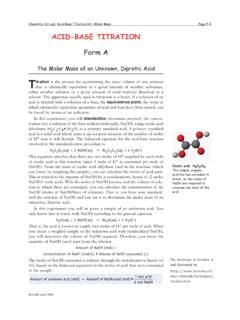Transcription of Chapter 06: Frictional Heating and Contact …
1 6 Frictional Heating and Contact temperatures Surface temperatures and Their Surface Temperature Analysis Analytical Methods for Flash Temperature Rise Calculations Numerical Methods for Surface Temperature Determination Surface Temperature Measurement Thermocouples, Thermistors, and Related Temperature Sensors Radiation Detection Techniques Ex Post Facto Methods Surface temperatures and Their Significance Friction occurs whenever two solid bodies slide against each other. It takes place by a variety of mecha-nisms in and around the real area of Contact between the sliding or rolling/sliding bodies. It is throughfrictional processes that velocity differences between the bodies are accommodated. It is also throughthese processes that mechanical energy is transformed into internal energy or heat, which causes thetemperature of the sliding bodies to increase.
2 The exact mechanism by which this energy transformationoccurs may vary from one sliding situation to another, and the exact location of that transformation isusually not known for certain. It is known that solid friction and related Frictional processes, includingfrictional Heating , are concentrated within the real area of Contact between two bodies in relative investigators contend that these processes occur by atomic-scale interactions within the top severalatomic layers on the contacting surfaces (Landman et al., 1993), while others believe that most energydissipation occurs in the bulk solid beneath the Contact region by plastic deformation processes (Rigneyand Hirth, 1979). Experimental work has shown that at least 95% of the energy dissipation occurs withinthe top 5 m of the contacting bodies (Kennedy, 1982). Although there may be disagreement about theexact mechanism of the energy transformation, most tribologists agree that nearly all of the energydissipated in Frictional contacts is transformed into heat (Uetz and F hl, 1978).
3 This energy dissipation,called Frictional Heating , is responsible for increases in the temperatures of the sliding bodies, especiallywithin the Contact region on their sliding surfaces where the temperatures are highest. For the purposesof this discussion, it will be assumed that all Frictional energy is dissipated as heat which is conductedinto the contacting bodies at the actual Contact Heating and the resulting Contact temperatures can have an important influence on thetribological behavior and failure of sliding components. Surface and near-surface temperatures canbecome high enough to cause changes in the structure and properties of the sliding materials, oxidationof the surface, and possibly even melting of the contacting solids. These temperature increases can oftenbe responsible for changes in the friction and wear behavior of the material or the behavior of any Francis E.
4 Kennedy Dartmouth College lubricant present in the Contact . Among the most important effects of Frictional Heating on tribologicalprocesses are the following: Sliding friction of materials with low melting points is often dominated by Frictional heatingeffects. The low sliding friction of ice and snow is due to the presence of a thin lubricating layerof meltwater which results from Frictional Heating of contacting ice crystals (Bowden and Hughes,1939; Oksanen and Keinonen, 1982; Akkok et al., 1987). The low friction brought about bymeltwater lubrication is critical for winter sports such as skiing, ice skating, and bobsledding. Thetemperature rise at the contacting ice asperities may not be sufficient to cause melting at very lowsliding speeds; as a result the friction coefficient of ice and snow at very slow velocities may be ashigh as to , but as soon as higher sliding velocities cause sufficient melting of the surfaceto produce a lubricating layer, the friction coefficient drops below (Kennedy et al.)
5 , 1999). Even metallic components can have Contact temperatures which are sufficiently high to melt thesliding surfaces within the real area of Contact if the sliding speeds are high enough. As is the casewith ice, this results in a thin lubricating layer of molten material which lowers the frictionsignificantly and increases wear (Montgomery, 1976; Carignan and Rabinowicz, 1980). Such acondition occurs with rocket sleds and with projectiles traveling in gun barrels. Elastomers and polymers also have friction and wear behavior which is significantly affected byinterface temperatures . This regime of tribological behavior has been called the thermal controlregime (Ettles, 1986). Frictional Heating can cause surface temperatures to reach the melting orsoftening temperature of thermoplastic polymers, and this results in a drastic change in the frictionand wear behavior of the polymer (Lancaster, 1971; Kennedy and Tian, 1994).
6 In fact, Lancastershowed that the PV limit, which is often used in the design of dry plastic bearings, is in realitya critical surface temperature limit ; , the combination of Contact pressure and sliding velocitycauses the surface temperature to reach the critical temperature of the material (Lancaster, 1971).Even if the surface temperature does not reach the critical temperature, the viscoelastic behaviorof the polymer or elastomer can be significantly affected and the resulting friction can be altered(Ettles and Shen, 1988). Design methodology has been developed for polymer bearings based onthe avoidance of surface temperatures which could be detrimental to their tribological performance(Floquet et al., 1977). In normal circumstances, most metallic tribological components do not have Contact temperatureswhich approach their melting or softening point, but the temperatures can still have a very majoreffect on their tribological behavior.
7 The phenomenon of galling or seizing of metals results from a combination of Contact temper-ature and Contact pressure at asperity junctions sufficient to cause microwelding of the twosurfaces at those points. A galling criterion based on thermal considerations was developed byLing and Saibel (1957/58). The oxidation which occurs on sliding metallic surfaces exposed to air or to oxygen-containinglubricants is of great practical importance. When the oxide film is coherent and well bondedto the surface, it is beneficial because it prevents metal metal Contact and thus lowers wear andfriction. When the oxide film is easily removed from the surface, however, oxidation is detri-mental because it promotes wear by third-body abrasion by hard oxide particles. The subjectof oxidation in sliding components and its relation to surface temperatures was reviewed byQuinn (1983) and Quinn and Winer (1985).
8 Contact temperatures and the resulting thermal stresses can play an important role in wear ofsliding metallic components. The fact that temperature gradients around the contacts are verylarge can be responsible for softening and shear failure of the near-surface layer of the materialin many situations (Rozeanu and Pnueli, 1978). The thermomechanical stress field around asliding Contact can be responsible for wear of the contacting materials, and it can be an important wear mechanism for both ceramics and metals; such wear can be modeled by the thermomechanical wear theory (Ting, 1988). Wear mechanism maps have been developed in recent years to show graphically the transitionsbetween the different mechanisms of dry sliding wear of metals (Lim and Ashby, 1987). Manyof the wear mechanisms, such as mild oxidational wear, severe oxidational wear, and melt wearare very much affected by temperature, and the transitions can be dominated by contacttemperature effects.
9 As a result, the wear mechanism maps are, to a large extent, based onsurface temperature maps (Lim and Ashby, 1987; Ashby et al., 1991). Owing to the high hardness and low thermal conductivity of many ceramics, the real Contact areasof sliding ceramic components are often very small and very hot (Griffioen et al., 1986). The highcontact temperatures and large temperature gradients can be responsible for large thermomechan-ical stresses which cause thermocracking and wear of the sliding ceramic surfaces. These phenom-ena are particularly important for ceramics such as zirconia which are susceptible to thermoelasticinstability and thermocracking (Lee et al., 1993). Contact temperatures may play an even greaterrole in wear transitions for ceramics than in those for metals (Hsu and Shen, 1996). Scuffing or scoring is an important failure mode for lubricated sliding or rolling/sliding compo-nents such as gears or cams.
10 Most models for scuffing failure are based on a critical contacttemperature which causes scuffing by either weakening the lubricant film so it is unable to supportthe load (Blok, 1937; Dyson, 1975) or increasing the shear stress in the film to a limiting value(Jacobsen, 1990). The effect of temperature on the lubricant and its additives is also important(Enthoven et al., 1993). The effectiveness of boundary lubrication is strongly dependent on Contact temperature. Frictionand wear with lubricants containing physically or chemically adsorbed additives deteriorate rapidlywhen the Contact temperature reaches a critical value at which the additive molecules desorb (Feinet al., 1959). The role of Frictional heat in the lubricant transition has been well established (Ettleset al., 1994). Lubricants containing extreme pressure (EP) additives rely on high Contact temperaturesto promote the formation of protective films on the Contact surfaces (Spikes and Cameron, 1974).







